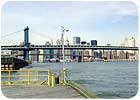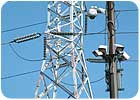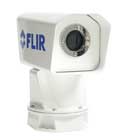
Bob Sommerfeld is president of Adesta LLC, which has completed or recently undertaken security projects at the ports of Long Beach (shown here) and Los Angeles, Calif.; Houston and Corpus Christi, Texas; Baltimore; and Mobile, Ala.

Southwest Microwave Volumetric and Protech Doppler Microwave Sensors provide instant alerts of any intrusion which can be verified by the video from the dome camera at this critical infrastructure site.
“Eighty percent of what we do is outdoor related,” says Rob Hile, vice president of business development at Adesta LLC, Omaha, Neb., which ranks No. 14 on SDM’s 2007 Top Systems Integrators Report. “We specialize in large corporate campuses and industrial complexes, seaports, and dams and locks. Those are all large acreage outdoor challenges in terms of surveillance, long distances, and tend to be very comprehensive in terms of integrating multiple technologies.”
The majority of perimeter security projects designed by Universal Security Systems, Hauppauge, N.Y., are in the firm’s core vertical markets of industry and infrastructure. These include public utilities, petro-chemical facilities, and government operations.
“We’re seeing a mix of utilizing existing, time-proven technology as well as starting to introduce a number of new technologies in terms of the sensors that we’re using to protect the perimeter,” relates Ed Newman, vice president of the firm ranked as No. 68 on SDM’s Top Systems Integrators Report.
Some of the latest security technologies that can meet the demanding requirements of such facilities are millimeter wave radar systems, video analytics and fiber optic intrusion sensors for fence lines, Newman says. Radars, of course, were developed in the 1940s, but are relatively new to the security integration market.
“All of these technologies are designed to not call a central station. They’re designed to improve situational awareness for the security operator — having a human being responding,” Newman says, meaning that these technologies are not for your everyday, middle commercial market.
While it may seem that the potential market for these types of technologies is slight, in fact there are some significant opportunities for implementing them in the United States:
- 300 ports
- 80,000 dams
- 66,000 chemical plants
- 2,800 power plants
- 300,000 energy production sites

'Most of the port operations we deal with, if there's a threat, we want to identify that threat from as far away as possible so they can deal with it before it gets close. It's a very sound philosophy.'
- Rob Hile, Adesta LLC
- Rob Hile, Adesta LLC
“One of the more interesting projects we’ve done is the seaport of Corpus Christi, Texas, over a $5 million project,” Hile says. “It was to provide integrated physical security, access control, and intrusion detection systems utilizing video analytics.”
Others are the ports of Houston, Los Angeles, Long Beach, Baltimore, and Mobile, Ala., where the solution used video analytics to monitor vessel traffic in and out of the port. A major component of that project was a network that facilitated communication to port police.
Due to the large-scale coverage area of a port, many of Adesta’s projects include a major communication backbone of either fiber or wireless. The company has a communications division, “so we can combine not only the security technologies, but the infrastructure that allows the video and data to flow back to the command and control center,” Hile explains.
“We are particularly excited about the recent contract award Adesta received from the Port of Long Beach,” says Bob Sommerfeld, president of Adesta.

THE THREAT & THE CHALLENGE
“Typically in a port environment you have a tremendous amount of fence or perimeter footage,” Hile says. “Not only that, you’ve got threats that are land-based or water-based, so that makes it even more difficult to secure. There are multiple technologies you would use over water or fence detection, which is why you’re going see that surveillance, when combined with sophisticated video analytics, is the de facto standard for security for ports, because you can cover large amounts of area with one camera that’s properly positioned.”Video analytics, Hile explains, allow guards to function more effectively “because the analytics help them do their jobs,” he says. “You’re more secure, it’s easier to operate, less false alarms, and you can cover a vast amount of area with just one camera. Today, [it] is definitely a viable technology. It is highly reliable; the customers are becoming more used to using it.”
Ports are considered harsh environments because of the sea water, which often causes products to break down or generate too many false alarms.
In addition, the nature of the threat can vary widely from port to port, partly because port operations vary in the type of cargo, Hile says. But, in general, all ports need to monitor the flow in and out of the facility. Authorities need to understand the destination of a vessel or truck, and monitor when it leaves to make sure it has the correct cargo and is heading in the right direction. A security system’s job is to detect anomalies in those patterns, Hile explains.
“And then it gets deeper than that,” he reveals. “Once these vessels or trucks get where they’re going, they use the access control to identify that the people getting on and off are supposed to be in the vessels that they are in.”
Adesta works closely with its access control system vendors to ensure they are ready for TWIC, which corresponds to the Transportation Workers Identity Credential, and also to design the system so that port security officials can easily and accurately identify individuals traversing through the ports.
Hile explains that one of the greatest potential threats is someone bringing a dirty bomb or nuclear bomb into the country through a port of entry.
A common approach among port security buyers is “from the curb in,” Hile says, meaning the security solution begins at the extended perimeter of the port and moves inward. Adesta is part of an organization called the American Association of Port Authorities.
“Most of the port operations we deal with, if there’s a threat, we want to identify that threat from as far away as possible so they can deal with it before it gets close. It’s a very sound philosophy,” he emphasizes.

'The radar system provides a range and vector to target, the same as it would to a missile system. Instead of locking a missile onto the target, we're locking a camera onto the target.'
- Ed Newman, Universal Security
- Ed Newman, Universal Security
“In the past, most of the sensors were intrusion detection systems. Intrusion detection, by its nature, detects the event after it’s happened,” Newman says. “One of the things we’re trying to move toward is early warning, or threat detection. Instead of detecting the event of person climbing the fence, we want to see somebody walking on the other side of the fence.
“With systems such as video analytics and radar, I can now push my sensing ability beyond my perimeter into either other privately owned property or public spaces,” Newman relates.
A good example is waterfront area, because most waterfront is public domain with little restriction on who can traverse it.
“The concern is that a person in a boat could pull right up to the dock at a refinery or nuclear power plant and you wouldn’t know it until the person climbed right up on the dock, which is too late,” Newman explains. “Now, with this new technology, we can detect that person as they approach the dock and be proactive with the response.”
The response can be automated, such as tracking with cameras or making audible announcements to leave the premises; or it can be to dispatch security personnel to the location.

THE TECHNOLOGY: RADAR
For open areas, outdoor PIRs and photoelectric beams haven’t been replaced. Rather, radar technology is being used to “supplements gaps that couldn’t be filled by long-range PIRs or beams,” says Brent Franklin, president of Unlimited Technology in Chester Springs, Pa. “The ground-based radar is filling the void when you have a mixed terrain like land and water. The manufacturers have taken a military technology and adapted it for the security industry.”In the projects done by Universal Security Systems, the radar system will connect multiple radar detection devices to a computer network back to a server, which will process the information and present it in a usable form to the security operator, Newman explains.
Most radar systems are capable of tracking dozens of targets simultaneously — not like a traditional sensor where the zone is either on or off, Newman claims.
The target creates a “radar signature,” allowing all sorts of potential threats to be tracked, such as people, cars and trucks, boats, and sometimes even local air traffic, Newman admits.
In operation, a radar system would be integrated with a camera system for tracking targets as they are detected and for recording surveillance images. But only in certain situations, such as a boat that comes down a river and stops within a set distance of the dock, will an alarm be triggered and a security operator be required to respond.
The installed cost of a single radar is approximately $100,000, Newman quotes, adding that a typical installation might involve two radars. “It seems like a lot of money, but when you look at the cost to employ a beam-based system, it’s often that much or more,” he says.
Equally important as the radar is the tracking camera, because even if the radar can detect a threat, your customers’ security responders may not be able to see it, Newman explains. Much depends on whether it’s day or night, and on weather conditions. “We’re selling a lot of thermal imaging systems, because they work off of infrared. They’re not degraded by rain or snow; it will see much better. We’ve done tests and demonstrations at night and in heavy fog and snow and the results are amazing in terms of being able to detect and view these threats,” Newman relates.
“The most powerful presentation we do is a radar with a thermal imaging camera right on top. It lets us go out at night in bad weather and show that we can detect and visually confirm a threat a mile outdoors at night in rain, snow and fog by using these two military technologies,” Newman says.
THE TECHNOLOGY: VIDEO ANALYTICS
Universal Security began using video analytics three or four years ago, taking a cautious approach to it at first. “While we quickly found that the basic technology worked, we found that the level of expectation of the customers was much higher than the product could provide,” Newman admitted.He explains that there was a learning process that involved determining a realistic percentage to achieve for detection as well as for false alarms.
“The two are very closely interrelated. In many cases we were able to achieve 100 percent detection, but at a very high cost on the false alarm side. We also found that the typical environment that video analytics have been demonstrated at and often tested, do not necessarily reflect where the customer wanted them to work in the real world,” he says.
Sites that Universal Security faced were areas often filled with large groups of people, moving vehicles, trees where the foliage moves around, lighting conditions such as shadows and reflections, as well as textures such as gravel or material on shelves. “Analytics work very well when you have high contrast, large objects and smooth backgrounds. When we try to introduce analytics in a scenario where we have shadows and trees moving around, the analytic is much more challenged by that environment,” Newman relates.
Universal Security has invested time, Newman says, to work with manufacturers to enhance software to work in such situations. Something that people don’t understand or know about video analytics is the great amount of processing power that’s required, Newman thinks.
“To be able to do one channel of ‘object-left-behind,’ we actual need to do not only object-left-behind, but we have to look for reflection of object. We need to look for shadows. We need to look for people and be able to say that person standing there is not an object left behind. We need to be able to look for headlights. It lets us maximize the sensitivity of object-left-behind and process this event through these other algorithms. ‘Hey, this looks like an object left behind – is it a tree, a shadow, a person?’ After it runs through all these filters, if it still gets to the bottom, then we report it as an object-left-behind. The pros and cons are we’re able to achieve a very high level of detection and a low level of falsing, so you get a very happy customer. The video analytic that cries wolf too often will just get ignored,” he relates.
“The downside is it takes a lot of processing power to do that. If we’re going to run one detection algorithm and it needs seven filters, that’s eight algorithms that the computer has to run. So the systems that we’re selling would take eight times the processing power or take up eight times as much space on the computer. So where brand A can run 32 channels on this computer, we’re only going to run four,” Newman explains.
Other ways that a video analytics solution can challenge integrators is in the camera stability. Hile explains that early generations of video analytics worked with other manufacturers’ cameras, but to speed up the evolution of the software and to compensate for products such as image stabilization and low light, some analytics companies began developing their own cameras in order to enhance the ability for their cameras to work.
Typically in port or other outdoor applications, cameras are mounted 80 to 100 feet and higher, and can be affected by wind. Image stabilization compensates for any potential sway to the camera.
“So analytics are getting better because the surveillance technologies are getting better,” Hile explains.
He believes that later versions of analytics are much more precise to the market’s needs. With early systems, “if you wanted a different solution, you had to go to a different manufacturer. Some worked very good over water and some didn’t. Some did a very good job of detecting vehicles stopping where they weren’t supposed to and some didn’t.
“Later versions are building in more functionality. Some have a package preconfigured out of the box. It comes with the camera, housing, lens, analytics software — and it’s tuned for that solution, for a specific threat application,” Hile says.
True video analytics that can function in environments such as ports or expansive utility plants can be very expensive to deploy, to the tune of $10,000 per channel installed. This is in contrast to lower-end systems in which all the customer may need is intelligent motion detection, which can be installed at around $1,000 per channel, Newman says.
“On the higher end there is a significant amount of professional services that go into it to tune the product. There might be nine days worth of labor to adjust it and to analyze data and tune the program to get you that 99 percent accuracy,” he claims.
Markets expressing interest in utilizing video analytics are critical infrastructure such as ports, utilities, hospitals, petro-chemical, government, airports and mass transit, integrators say.
“We’ve seen a lot of interest from all kinds of unusual applications, and I think as the industry evolves, we’ll go from maybe two dozen analytics generally available right now, to maybe thousands,” Newman says.
THE TECHNOLOGY: FIBER-BASED FENCE SENSORS
One newer technology integrators are depending on for critical infrastructure sites is fiber optic perimeter sensors, and there are several companies that make solutions. Integrators claim that the larger the site, the better suited it is for perimeter fence detection using fiber optics. The reason is because of its precise detection capabilities.“Traditionally [vibration detection systems] worked well where you have a large perimeter fence line. The problem is it has these big detection zones. If you have a 20-mile perimeter it might only have 20 zones. Somewhere along the fence, somebody just climbed over or cut the fence,” Newman says.
The advantage of some of today’s fiber-based systems is that they can detect a breach to within a few meters of where the vibration is.
“We’re seeing more interest in those systems now. But you need to have a very large perimeter to make that effective. The computer head end can cost upwards of a few thousand dollars. Per foot on the perimeter, it might only be a dollar per foot, but you have to get past this initial big cost,” he explains.
The market for fiber detection includes sites such as refineries and airports. “Some of the other infrastructure clients such as utilities tend to fall off because their properties tend to be smaller. The system works well when you have 300 or 3,000 acres versus 30 acres,” Newman thinks.
Unlimited Technology, ranked No. 77 on SDM’s Top Systems Integrators Report, also has applied fiber fence detection technology in critical infrastructure and airports. “It’s not something that the small private sector would get into. It’s a larger scale technology that would be used in more mission-critical applications, such as pipelines,” says Ian Francisco, principal and CTO of Unlimited Technology.
Francisco likes the technology because it is not affected by weather conditions or electrical interference, and it has a very low false alarm rate. “It’s almost impossible to get around it,” he claims.
The fiber acts as a passive transducer. “The fiber being passive is the first key and the head-end, which is very complicated, is the second. It was developed with a built-in algorithm to tune out most of the items that cause false alarms.
“The second ‘pro’ is the fact that we can go 160 kilometers on that system and it will detect plus or minus 10 feet of where someone is on the fence. This will allow you to put a camera on the intruder. No boxes are needed out in the field,” Francisco says.
The initial cost for the head-end can run approximately $200,000, he adds, and then it’s a fixed cost per foot.
“The system is very accurate, very low maintenance, and easily administered from remote command centers.”

Technology Research List
Vendors of Outdoor and Perimeter Security Solutions
ADPRO, division of Xtralis
www.xtralis.com | (800) 229-4434
The ADPRO product line consists of a range of interactive video, video analytics and the Pro-series outdoor passive infrared detectors.
Arteco Vision Systems
www.artecous.com | (314) 426-5331
The Arteco Intelligent Video Solution (IVS) is a combination of intelligent surveillance products that work together to create a security solution for any size business or organization. With the IVS, surveillance becomes a pre-emptive, actionable intelligence to assist security professionals in real time.
www.xtralis.com | (800) 229-4434
The ADPRO product line consists of a range of interactive video, video analytics and the Pro-series outdoor passive infrared detectors.
Arteco Vision Systems
www.artecous.com | (314) 426-5331
The Arteco Intelligent Video Solution (IVS) is a combination of intelligent surveillance products that work together to create a security solution for any size business or organization. With the IVS, surveillance becomes a pre-emptive, actionable intelligence to assist security professionals in real time.

www.boschsecurity.com| (800) 289-0096
A new firmware release for Bosch IP video products delivers critical features for video content analysis along with other enhancements, including a recording scheduler and encryption.
Continental Instruments
www.cicaccess.com| (631) 842-9400
The CardAccess CA3000 system is a full security-management suite that provides the technological backbone needed to be able to support, manage, and protect today’s schools, hospitals and corporations. The system offers access control, ID credential issuance and management, alarm monitoring, digital video surveillance and management, integration of biometric technologies, intrusion detection, visitor management, and smart card functionality.
Duos Technologies
www.duostech.com| (904) 296-2807
Duos produces intelligent video solutions for high-security requirements, including critical Homeland Security applications. These solutions combine video, intuitive software, data storage, and information technology using the company’s proprietary rvspro digital video recorder and transmission server.
DynaPel
www.dynapel.com| (800) 997-7934
DynaPel Systems Inc. is a developer of intelligent video surveillance software and hardware appliances for physical security applications. DynaPel products increase the effectiveness of video surveillance operations for commercial and government organizations.
Firetide
www.firetide.com| (408) 399-7771
Firetide is a provider of multi-service mesh networks for industrial and municipal applications. Firetide provides a secure, high-performance wireless mesh infrastructure and access solution for video surveillance, Internet access, public safety networks, and temporary networks.

www.flirsystems.com| (800) 727-FLIR (3547)
FLIR Systems offers thermal imaging systems for any security application, including border security, port security, and critical infrastructure applications.
Fluidmesh Networks
www.fluidmesh.com| (617) 850-9007
Fluidmesh Networks provides wireless video surveillance systems based on mesh networking technology. Applications include large areas at risk such as municipalities, industrial plants, seaports and marinas, archaeological sites, resorts, theme parks and racing tracks.
Honeywell Security
www.honeywellsecurity.com| (800) 467-5875
Honeywell Security has a complete, integrated solution, offering everything from radar and video solutions, including analytics, for the perimeter to visitor management and card access for offices.

www.gesecurity.com| (888) GE-SECURITY (437-3287)
GE can secure port operations with explosive/narcotic trace detection, access control, intrusion alarms and video systems. GE’s container security system detects unauthorized intrusions and sends an alarm at any point in the supply chain if the container’s integrity has been compromised.
ICX Radar Systems
www.amphitech.com| (450) 663-4554
ICX Radar Systems (formerly Amphitech) develops MMW radar systems for airborne, shipborne and ground surveillance applications. Millimeter wave perimeter security radar has the ability to penetrate poor visibility environments, to quickly detect moving targets over a 360 degree field of view, and accurate ranging capability.

www.ioimage.com| (877) 383-2913
ioimage’s intelligent video edge devices combine high-performance analytics with a unique design for simple deployment. The company helps homeland, public and commercial organizations with its range of self-sufficient DSP-based intelligent video encoders, IP cameras and video analytics.
K&G Spectrum
www.kgspectrum.com| (819) 595-0856
K&G Spectrum is a manufacturer of radar-based perimeter intrusion detection systems which are compact, reliable, low-emission millimeter waves radars.
Lenel Systems, a UTC Fire & Security Co.
www.lenel.com| (585) 248-9720
Lenel’s OnGuard Total Security Knowledge Management Solutions integrate synergistic technologies using open architecture design standards. Individual application modules are available as standalone systems or can be deployed in any combination to deliver a single integrated solution.
Magal Senstar Inc.
www.magalsenstarinc.com| (800) 676-3300
Magal-Senstar delivers advanced security systems and solutions — from the perimeter to the control room. The company’s products are the result of 130 years of combined experience protecting airports, borders, nuclear facilities, maximum security prisons, military bases and other sensitive installations in more than 75 countries.
Object Video
www.objectvideo.com| (703) 654-9300
Intelligent Video on a chip: Object Video provides original equipment manufacturers (OEMs) with targeted software solutions that fill the requirements for a variety of industries.

www.optellios.com| (215) 741-5850
The company’s Fiber Patrol division features a product suite of application-specific fiber-optic based intrusion detection and alarm management solutions. Optellios has integrated its Fiber Patrol products with many of the top CCTV, access control, and analytic video platforms.
Optex Inc.
www.optexamerica.com| (800) 966-7839 or (909) 993-5770
Optex manufactures high-technology security products for both outdoor and indoor applications, including photoelectric and passive infrared detectors.
Protection Technologies Inc.
www.protechusa.com| (800) 428-9662
For more than 20 years, Protech has provided military, government, commercial and industrial users the highest standard in intrusion sensors. Protech utilizes a proprietary dual-channel microwave design in all of its intrusion sensor products. Stereo Doppler technology is the key to Protect sensors’ unique false alarm immunity.
Rokonet
www.riscogroup.com| (800) 344-2025 or (305) 592-3820
Risco Group’s outdoor detectors provide reliable outdoor protection and incorporate unique technologies for providing selective event recognition.

www.sightlogix.com| (609) 951-0008
SightLogix has developed a patented system architecture that combines high-quality, long-range cameras with analytics in an edge device that performs target detection and surveillance, right from the edge of the network.
Smarter Security Systems Ltd.
www.smartersecurity.com| (800) 943-0043
Key product lines include the Fastlane brand of entrance control solutions as well as remote wireless DVR systems, perimeter systems, and remote power solutions.
Tyco Fire & Security
www.tycofireandsecurity.com
Company helps protect people and property with its world-leading access control, digital video solutions and intrusion alarm systems, among other advanced technologies.
VideoIQ
www.videoiq.net| (781) 222-3069
VideoIQ offers a video analytics solution that transforms video surveillance into a real-time intelligent system for guarding against intruders, and gaining early warning of security breaches in nearly any environment.
videoNEXT
www.videoNEXT.com| (866) 723-3077
Security Knowledge Manager (SKM) secures physical infrastructures as well as offers management solutions to protect mission-critical data and advanced recording and monitoring capabilities for internal and external transactions.
Vidient
www.vidient.com| (408) 970-8240
Vidient SmartCatch provides the most comprehensive, accurate and advanced site-wide intelligent video surveillance solution available. With true behavior recognition capabilities, SmartCatch can detect suspicious behaviors that threaten safety and security in real time, alerting the appropriate security staff for an effective and efficient response.
Vistascape Security Systems
www.vistascape.com| (678) 919-1130
VistaScape’s SiteIQ surveillance solution displays a bird’s eye view of an entire physical environment on one screen. It allows you to secure facilities with or without existing perimeter barriers by combining input from multiple cameras with other sophisticated, site-specific sensor data.



